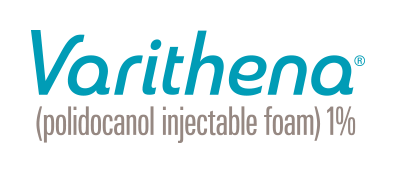Dr. Jimenez 2021 publication
Patients
(n= 99; single center)
- Symptomatic varicose veins patients (C2 – C6) associated with either saphenofemoral or saphenopopliteal vein reflux
- 129 limbs in 99 patients were treated
- Veins treated included: great saphenous vein (n=89), anterior accessory saphenous vein (n=15), small saphenous vein (n=14), and tributary veins (n=56)
Methods
Retrospective review between April 2018 and August 2020
The following adjunctive techniques were performed when delivering treatment:
- Preoperative duplex ultrasound at the time of operation. Large perforator veins were localized and mapped before injection of microfoam
- Limb elevation to greater than 45°
- Injection of 10 mL of sterile saline before microfoam infusion to displace blood from the vein
- Attempted limitation of microfoam volume to 5 mL or less (if possible). The mean volume of microfoam used per session was 7.6 ± 3.3 mL
- Compression of the axial vein 5 cm caudal to the saphenofemoral or saphenopopliteal junctions and compression of perforator veins during microfoam injection
- Dorsiflexion and plantar flexion of the ipsilateral foot and ankle for 20 repetitions after microfoam injection
Key results
- Immediate closure rate was 95% with 81% overall symptomatic relief at last follow-up
– The mean follow up was 113.5 days for the entire patient population - Two limbs (1.5%) required postoperative anticoagulation for thrombus extension into the deep venous system (common femoral vein n=1, popliteal vein n=1) postoperatively. Both resolved with anticoagulation
- One asymptomatic limb developed a femoral vein deep venous thrombosis (DVT) and resolved following 3 months of anticoagulation
- One symptomatic late DVT was noted four-months post-procedure*
- No pulmonary emboli were noted, and no neurologic or visual adverse events were reported
Conclusion
- The rate of non-occlusive extension of thrombus into the deep system following treatment was 1.5%, markedly lower than incidence in thermal ablation reported in current peer reviewed literature
- With the use of these adjunctive techniques, this study demonstrated minimal deep venous thrombotic adverse events following microfoam ablation and lower ATE’s than reported in early Phase III clinical trials
Comparison of Adverse Thrombotic Events (ATE’s) Across Studies
| Study | Common femoral or popliteal extension | Other deep venous thrombosis | % of total ATE's in study | Symptomatic | Patients with ATE's anticoagulated |
|---|---|---|---|---|---|
| VANISH 12 | 5.5% | 3.3% | 8.8% | 22% | Not stated |
| VANISH 23 | 3.9% | 6.6% | 10.5% | 33% | 50% |
| Jimenez, et al | 1.5% | 1.5% | 3.0% | 0.78% | 100% |
Study limitations
- Non-randomized, retrospective review
- Short period of follow up
* Femoropopliteal DVT occurred 4 months after microfoam injection following a long-haul airplane flight. She was later found to be heterozygous for Factor V Leiden.
1. Jimenez JC, et al. Adjunctive techniques to minimize thrombotic complications following microfoam sclerotherapy of saphenous trunks and tributaries. J Vasc Surg Venous Lymphat Disord. 2021 Jul;9(4):904-909. Epub 2020 Nov 26. PMID: 33248297.
2. King JT, O’Byrne M, Vasquez M, Wright D; VANISH-1 Investigator Group. Treatment of Truncal Incompetence and Varicose Veins with a Single Administration of a New Polidocanol Endovenous Microfoam Preparation Improves Symptoms and Appearance. Eur J Vasc Endovasc Surg. 2015 Dec;50(6):784-93. Epub 2015 Sep 16. PMID: 26384639.
3. Todd KL 3rd, Wright DI; VANISH-2 Investigator Group. The VANISH-2 study: a randomized, blinded, multicenter study to evaluate the efficacy and safety of polidocanol endovenous microfoam 0.5% and 1.0% compared with placebo for the treatment of saphenofemoral junction incompetence. Phlebology. 2014 Oct;29(9):608-18. Epub 2013 Jul 17. PMID: 23864535.
Indications
Varithena® (polidocanol injectable foam) is indicated for the treatment of incompetent great saphenous veins, accessory saphenous veins and visible varicosities of the great saphenous vein (GSV) system above and below the knee. Varithena® improves the symptoms of superficial venous incompetence and the appearance of visible varicosities.
Important Safety Information
The use of Varithena® is contraindicated in patients with known allergy to polidocanol and those with acute thromboembolic disease. Severe allergic reactions have been reported following administration of liquid polidocanol, including anaphylactic reactions, some of them fatal. Observe patients for at least 10 minutes following injection and be prepared to treat anaphylaxis appropriately. Intra-arterial injection or extravasation of polidocanol can cause severe necrosis, ischemia or gangrene. Patients with underlying arterial disease may be at increased risk for tissue ischemia. If intra-arterial injection of polidocanol occurs, consult a vascular surgeon immediately. Varithena® can cause venous thrombosis. Follow administration instructions closely and monitor for signs of venous thrombosis after treatment. Patients with reduced mobility, history of deep vein thrombosis or pulmonary embolism, or recent (within 3 months) major surgery, prolonged hospitalization, or pregnancy are at increased risk for developing thrombosis. The most common adverse events observed were pain/discomfort in extremity, retained coagulum, injection site hematoma or pain, common femoral vein thrombus extension, superficial thrombophlebitis, and deep vein thrombosis.Physicians administering Varithena® must be experienced with venous procedures, possess a detailed working knowledge of the use of the duplex ultrasound in venous disease and be trained in the administration of Varithena®.
See Full Prescribing Information for Varithena®
Varithena™ is a registered trademark of Boston Scientific. All other trademarks are property of their respective owners.
PI-1263705-AA


